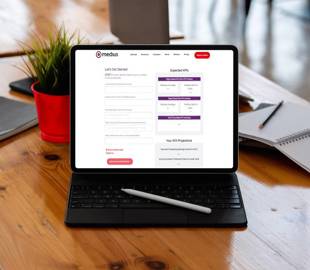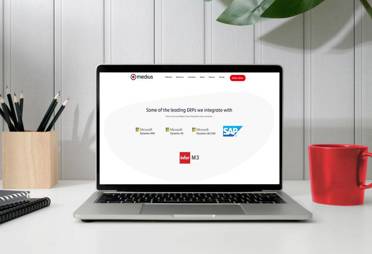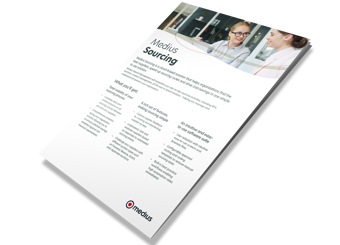

Strategic procurement is a company-wide procedure that ensures the timely delivery of goods and services following the company's business objectives while decreasing supply chain risk and cost.
Being able to source sustainable materials is ranked as the largest future challenge facing companies, with a score of 2.7 out of 3 1.
It's an activity that necessitates collaboration from various divisions within the company.
1 Accenture. 2021. Global Sourcing Reference 2022

What are the benefits of strategic sourcing?
According to a report by Grand View Research, global procurement is expected to see a growth rate of more than 11% through 2030 2.
Consider the direct and indirect positive impact that strategic sourcing can have on a company and its suppliers.
Improved guidelines for the future
The strategic methods let businesses gather data and make informed choices with a better idea of the outcome, which allows them to reassess current contracts.
This data collection analyzes pricing, quality, capacity, services offered, and other critical data points to take the mystery out of the procurement process.
Strategic sourcing gives insight into the most significant factors that should influence decision-making and light the way to better business practices.
Having a greater understanding of the full cost of ownership along a product's life cycle reveals ways a company can cut costs and improve the bottom line.
Improved relationships within the supply chain
- When businesses need to work with an extensive list of enterprises, it allows them to improve their relationships with all of them.
- Strategic sourcing can ensure that future procurement needs are laid out ahead to avoid situations that may harm the business financially or otherwise.
- Better supplier relations can open the way for more favorable contract terms and increase a business’s reputation.
Many factors can strengthen your supplier relationships. Read this article to discover the ins and outs of supplier management.
Better organization
Strategic sourcing increases the focus on long-term planning and allows business leaders to step away from time-consuming leadership duties.
They can focus on more pressing challenges that could affect them in the immediate future.
Using strategic data allows a company to audit its purchasing decisions systematically and automatically. This ensured the supplier selection with the best overall price and monitored the performance of suppliers over time.
Cost management
Controlling cost is one of the most important benefits of implementing a strategic sourcing solution into your business.
Strategic sourcing allows suppliers to sell a significant portion of their output, so they can improve planning and provide management with long-term cash flow visibility.
The supplier’s success is your company’s success as it creates a more stable trading environment.
Research by McKinsey found that companies that use strategic sourcing can realize a reduction of 10 to 25 percent in product and service costs.
They also experienced an associated reduction in process complexity and increased data quality.
Risk management
The close supplier relationships that strategic sourcing brings can help businesses identify and resolve potential problems quickly.
For example, if a strategic supplier has cash flow problems, a business may advance some working capital to continue operations.
Using a strategic method up-front helps to combat the disruptive trends seen in the supply chains of many industries and ensures your business has access to the correct supplier when needed.
Depending on the buyer, strategic sourcing may lead to supplier consolidation. If a retailer chooses to use one supplier instead of several, it allows for greater stability in the supplier's day-to-day operations.
2 Grand View Research, Inc. 2022, Procurement Analytics Market Size, Share & Trends Analysis Report By Component (Solution, Service), By Deployment, By Application, By Organization Size, By Vertical, By Region, And Segment Forecasts, 2022 - 2030, grandviewresearch.com.
Strategic sourcing best practices

Use eRFX events and eAuctions
Sourcing lets buyers automate and standardize how sourcing events are created, distributed, collected, and stored, allowing for greater efficiency than manual event management.

Use contract management software
Contract management software can help you manage any number of contracts, integrating details of preferred suppliers from e-sourcing events with custom fields to capture contract-specific data.
Supplier agreements can roll over with the right management tools into the next year, locking you into better pricing and service terms.

Track spend and savings
Instead of relying on spreadsheets to measure and report savings, a savings tracker solution can enable you to easily build up saving forecasts, create tracking documents and deliver reports that illustrate your deliverables and value.
Read this article to learn more details about improving your strategic sourcing.
What does the process of strategic sourcing look like?
Step 1: Profile the category
Define the category and commodities of the spend category. What is the current quantity used? Who are the users, and where are they located? What processes are used, and who is involved in the supply chain?
Step 2: Supply market analysis
Identify the potential global and local suppliers. Study the cost components of the product or service and analyze the suppliers’ marketplace for risks and opportunities. Variables like key raw material prices, labor, and transportation must be priced, along with calculating suppliers' cost elements.
Step 3: Develop the strategy
The next step involves deciding where you’ll buy while minimizing risk and costs. With the stakeholders on board, alternative suppliers and market competition must be considered.
Step 4: Select the sourcing process
Next, a business needs to develop a sourcing strategy. The most common process for soliciting bids is typically a Request for Proposal. This document will include product/service specifications, delivery and service requirements, pricing breakdowns, and legal and financial terms.
Step 5: Negotiate and select suppliers
As negotiations begin and valid bids are chosen, suppliers will ask for clarifications and more detail where needed. Conduct multiple rounds of negotiations and form a shortlist of your suppliers before selecting them as per your business' approval process.
Step 6: Implement and integrate
Notify the successful suppliers and ensure they’re involved in the implementation process. Your strategic sourcing strategy will include improvements to specifications or processes and changes in delivery or service requirements.
Step 7: Benchmarking and tracking results
The final step begins a continuous cycle that starts with benchmarking the status of the commodity or category, monitoring the results, and ensuring that full value is achieved. The strategic sourcing process is cyclical, and a business then goes back to Step 1 to review the supply market again and restart the process.
Tips to improve strategic sourcing.
Integrate with AP Automation
While business processes can be broken down into discrete steps like procurement and invoicing, the truth is that these functions should be dynamically linked.
Supplier relationships and savings increase as the accounts payable team and procurement staff work together.
AP automation opens up the opportunity to streamline the company’s payment processes. But procurement that is handled separately can complicate workflow and lead to:
- Uncontrolled, rogue spending
- Surprise invoices that require investigation and extra processing time
- Late payments and penalties due to additional manual interventions
On the other hand, an AP and procurement connection can provide common data that can protect your company from common risks.
This real-time data allows each department to have insight into the other's work, improving overall performance.
Read more about the strategic link between procurement and accounts payable.


Implement a solution with your ERP
Finding a strategic sourcing solution that connects to the tools your people are already familiar with will streamline the entire business workflow.
A software solution that integrates with common enterprise resource planning (ERP) systems becomes a more valuable tool to get your back-office and third-party systems to cooperate.
The eProcurement platform from Medius features:
- Out-of-the-box connectors and rest API calls to produce a rapid and predictable implementation timeline
- Seamless integration with supplier marketplaces for goods and services
- Built-in coordination with other Medius Spend Management modules
More resources we think you'll like


